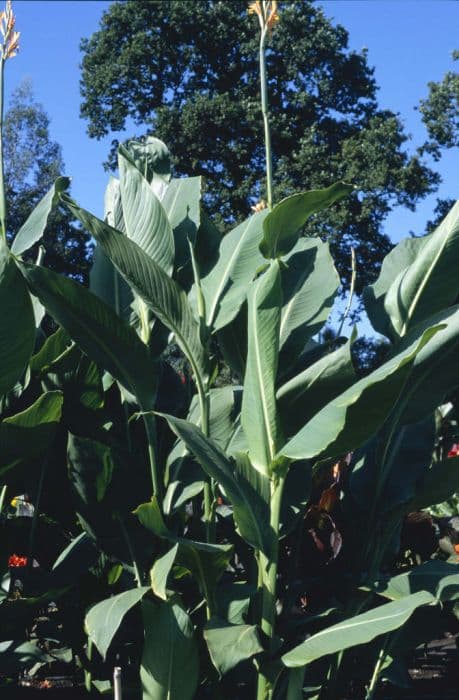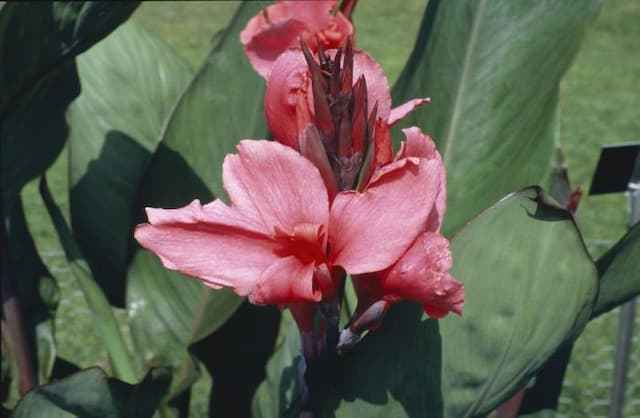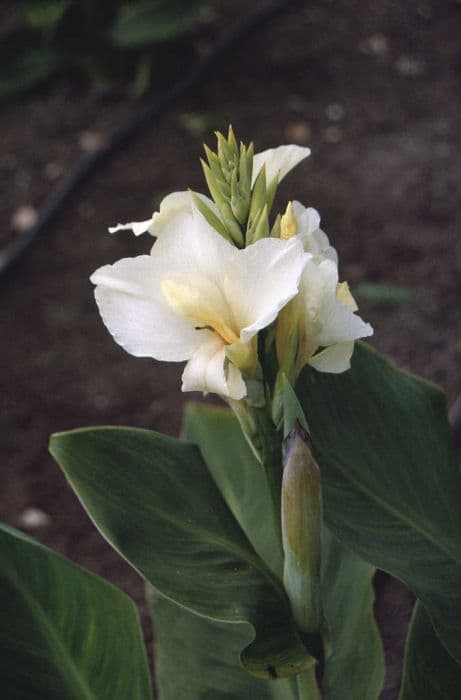Canna Lily Canna 'Erebus'

ABOUT
Canna 'Erebus' is distinguished by its striking foliage and vibrant blooms. The leaves are broad and paddle-shaped, typically displaying a lush green hue that can serve as a backdrop to the flowers. These leaves can sometimes have a tropical feel, adding an exotic touch to garden spaces. The showstoppers of Canna 'Erebus' are the flowers, which bloom in a magnificent gradient of colors typically ranging from soft peach to warm apricot tones. The petals have a slightly ruffled appearance, adding texture and depth to the already eye-catching blooms. Flowers cluster at the top of the stems, creating a bold visual display that draws attention. This plant also exhibits sturdy stems that keep the flowers and foliage aloft, providing a robust structure that complements its overall aesthetic. The plant has a lush, dense growth habit, contributing to its popularity as a choice for adding a tropical flair to gardens without overwhelming surrounding plants.
About this plant
 Names
NamesFamily
Cannaceae.
Synonyms
Canna Lily, Canna.
Common names
Canna Erebus.
 Toxicity
ToxicityTo humans
Canna 'Erebus', commonly known as Canna Lily, is generally not considered toxic to humans. However, like any plant, individual reactions can vary, and it is always advisable to avoid ingesting any plant material that is not meant for consumption. If any part of the plant is ingested, there are typically no known toxicity symptoms in humans, but it's possible that someone might experience an allergic reaction or an upset stomach due to the plant's fibrous nature.
To pets
Canna Lily is generally not toxic to pets such as dogs and cats. It is not listed among the plants commonly known to be poisonous to animals. However, as with any non-food plant, ingestion can potentially cause mild gastrointestinal upset, such as vomiting or diarrhea, due to the irritation of the stomach or intestines. If you suspect your pet has eaten a substantial amount of the plant and is showing symptoms, it is recommended to contact your veterinarian.
 Characteristics
CharacteristicsLife cycle
Perennials
Foliage type
Deciduous
Color of leaves
Green
Flower color
Pink
Height
3-4 feet (0.9-1.2 meters)
Spread
1-2 feet (0.3-0.6 meters)
Plant type
Bulb
Hardiness zones
7
Native area
Central America
Benefits
 General Benefits
General Benefits- Easy to grow - Canna 'Erebus' can thrive in a variety of soil conditions and doesn't require expert gardening skills.
- Drought-tolerant - Once established, it can withstand dry conditions, making it suitable for gardens in regions with water scarcity.
- Attracts wildlife - The bright flowers of the Canna 'Erebus' are attractive to hummingbirds, butterflies, and other pollinators, promoting biodiversity.
- Seasonal interest - It provides vibrant flowers and lush foliage during the growing season, adding aesthetic value to gardens.
- Low maintenance - Requires minimal care such as occasional deadheading and dividing, saving time and effort for gardeners.
- Versatility in landscaping - Can be used in borders, as a focal point, or in mass plantings, offering various design options for landscapers.
- Rapid growth - Quick to establish and grow, which quickly covers bare spots in the garden.
 Medical Properties
Medical PropertiesThis plant is not used for medical purposes.
 Air-purifying Qualities
Air-purifying QualitiesThis plant is not specifically known for air purifying qualities.
 Other Uses
Other Uses- Canna 'Erebus', also known as Canna Lily, can be utilized as a botanical ink source for art projects, with the petals providing vibrant natural pigments.
- The large, banana-like leaves are sometimes used as natural wrapping materials for food, in a manner similar to banana leaves in various cuisines.
- The fibrous stalks of the Canna Lily can be processed into paper or cardboard alternatives, showcasing an eco-friendly use for the plant’s structural components.
- Canna Lily seeds are hard and can be used as beads or buttons in craft activities, providing a natural and unique appearance for jewelry or clothing accessories.
- The sturdy stems can serve as natural garden stakes or supports for other plants, blending seamlessly into the garden aesthetic.
- Dried Canna Lily leaves can be woven into mats, hats, or other traditional handicrafts in certain cultures, displaying the plant’s versatility in material use.
- Canna Lily can contribute to a garden's aesthetic diversity by attracting beneficial pollinators like butterflies and hummingbirds, enhancing biodiversity.
- The plant's extensive root system helps to stabilize soil and prevent erosion, making it useful in landscape management and restoration projects.
- When planted in mass groupings, Canna Lily can be used as a privacy screen due to its tall and dense foliage, giving a lush, tropical green barrier.
- Used as a natural dye, Canna Lily flowers and leaves can impart color to fabrics and textiles, a practice that dates back to traditional dyeing techniques.
Interesting Facts
 Feng Shui
Feng ShuiThe Canna Lily is not used in Feng Shui practice.
 Zodiac Sign Compitability
Zodiac Sign CompitabilityThe Canna Lily is not used in astrology practice.
 Plant Symbolism
Plant Symbolism- Transformation: The genus name "Canna" comes from the Greek word for "reed" or "cane," which can symbolize change and transformation as reeds bend and adapt to the wind without breaking.
- Beauty: Canna 'Erebus' is known for its attractive foliage and flowers, making it a symbol of beauty in the garden.
- Fertility: Cannas are often found in very lush areas, where water is abundant. The vigorous growth and large leaves can symbolize fertility and the ability to thrive in various conditions.
- Presence: With its bold presence and large stature, Canna 'Erebus' can symbolize a commanding presence which cannot be ignored.
 Water
WaterCanna Lilies should be watered thoroughly to saturate the soil around the root zone, generally requiring about 1 inch of water per week. During hot or dry spells, increase watering frequency to keep the soil consistently moist but not waterlogged. A deep watering every few days is typically more beneficial than light daily watering, as it encourages deeper root growth. In containers, water Canna Lilies when the top inch of soil feels dry to the touch, making sure excess water can drain freely to prevent root rot. During active growth in the summer, this might mean watering several times a week with several gallons of water, depending on the size of the container and the environmental conditions.
 Light
LightCanna Lilies thrive in full sun conditions, needing at least six to eight hours of direct sunlight each day to produce vigorous growth and abundant blooms. The best spot for a Canna Lily is an area where it receives plenty of morning light and protection from the intense heat of late afternoon sun in very hot climates. They can tolerate partial shade, but flowering may be reduced.
 Temperature
TemperatureCanna Lilies perform best in temperatures between 60°F and 90°F. They can tolerate a minimum temperature of about 55°F; below this, the plant may suffer damage. During the growing season, maintain a warm environment, as Canna Lilies are tropical plants that do not tolerate frost and must be protected or moved indoors in regions where temperatures drop below freezing.
 Pruning
PruningPrune Canna Lilies to remove spent flowers and seed pods to encourage continued blooming throughout the growing season. It is also important to cut back the foliage after the first frost in fall or when the leaves turn brown, pruning to about 4 to 6 inches above the ground. This is typically the best time for pruning, as it prepares the plant for winter dormancy.
 Cleaning
CleaningAs needed
 Soil
SoilCanna Lily 'Erebus' thrives best in a rich, moist, well-draining soil mix with a pH of 6.0 to 6.5. Blend garden soil with compost and peat moss for optimal growth and flowering.
 Repotting
RepottingCanna Lily 'Erebus' should be repotted every 2 to 3 years or when it outgrows its pot, typically in early spring before the growing season begins.
 Humidity & Misting
Humidity & MistingCanna Lily 'Erebus' prefers moderate to high humidity levels but is adaptable and tolerant of a wide range of humidity conditions in the growing environment.
 Suitable locations
Suitable locationsIndoor
Provide bright light, warmth, and keep soil moist for Canna 'Erebus'.
Outdoor
Plant Canna 'Erebus' in full sun to partial shade, and keep soil moist.
Hardiness zone
7-11 USDA
 Life cycle
Life cycleStarting as a rhizome, Canna 'Erebus' will sprout shoots once temperatures are consistently warm. Leaves unfurl, forming tall stalks with characteristic large, banana-like green foliage, and the plant begins vegetative growth. As it matures, Canna 'Erebus' starts its reproductive phase, producing tall flower spikes with soft pink, iris-like blooms that attract pollinators. After flowering, seeds may develop, but propagation is primarily through division of the rhizomes. Growth slows as temperatures drop in autumn, with the plant entering dormancy over winter, especially in cooler climates where the rhizomes may need to be overwintered indoors. The cycle recommences in spring when the rhizomes are replanted or naturally re-sprout in consistently warm temperatures.
 Propogation
PropogationPropogation time
Spring-Summer
Propogation: Canna 'Erebus', commonly known as Canna Lily, is typically propagated during the spring season when the danger of frost has passed and the soil has warmed up. The most popular method of propagation for Canna Lily is by dividing its rhizomes. After the plant has finished blooming, or during early spring, gardeners should carefully dig up the clumps of rhizomes and gently pull or cut them apart, ensuring that each section has at least one eye, which is a growing point. These sections are then replanted in well-draining soil at a depth of about 4 to 6 inches (approximately 10 to 15 centimeters), spaced approximately 1 to 2 feet apart (30 to 60 centimeters). The rhizomes will develop into new plants that will mature and bloom over the summer months.









